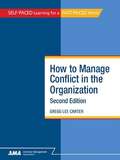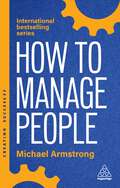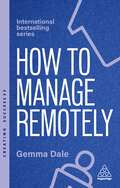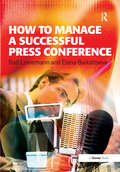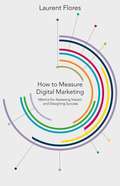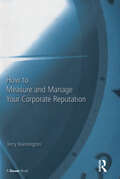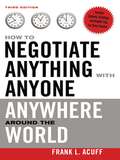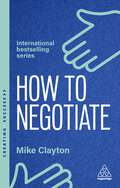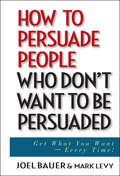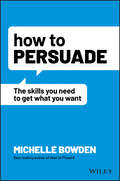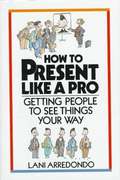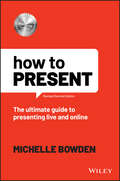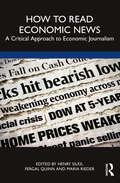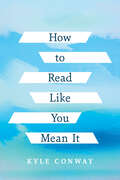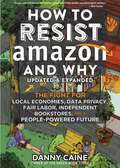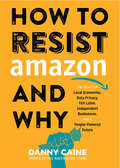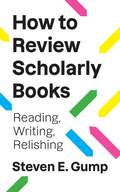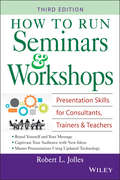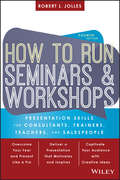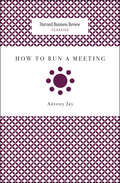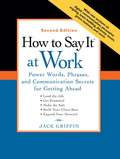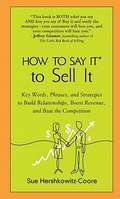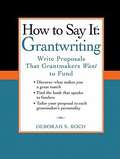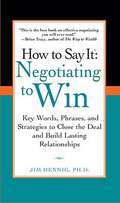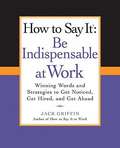- Table View
- List View
How to Manage Conflict in the Organization, Second Edition
by Gregg Lee Carter Joseph F. ByrnesGain control of tough conflict situations and transform them into a productive force in your organization. How to Manage Conflict in the Organization, Second Edition, equips you with the strategies, tactics and insights you need to gain control of tough conflict situations. You´ll discover how to spot potential interpersonal conflicts—and defuse them before they flare up. You´ll understand how, when, where and why to apply the five favored conflict-resolution approaches, and you´ll develop the insight and intuition you need to make them work. This book will give you the skills to transform conflict into a positive, productive force by applying the proven techniques of principled negotiation. You will learn how to: • Transform conflict into a positive, productive force • Respond to on-the-job conflicts quickly and effectively • Resolve conflicts positively using proven principled negotiation techniques. • Understand the differences between structural (organizational) and interpersonal conflict • Separate people from issues and focus on interests, not positions • Get beyond immediate tensions and disagreements to the root causes of any interpersonal conflict • Apply five surefire conflict-resolution approaches: avoiding, accommodating, compromising, forcing, and collaborating • Adopt best practices for implementing alternative dispute resolution techniques • Develop strategies for dealing with conflict resolution in electronic communication • Follow guidelines for when to consult with HR about a conflict-resolution situation
How to Manage People: Fast, Effective Management Skills that Really Get Results (Creating Success)
by Michael ArmstrongBestselling author Michael Armstrong provides valuable insight into the skills required to be an effective manager, helping you get the best from your staff through motivation, reward and leadership.This fully updated 6th edition now features even more practical exercises, useful templates, and top tips, alongside advice on managing virtual teams, enhancing employee engagement and managing conflict. Essential reading for anyone who wants to get the best from their teams, How to Manage People distils the essence of good management into one handy, easy-to-use book.The Creating Success series of books...Unlock vital skills, power up your performance and get ahead with the bestselling Creating Success series. Written by experts for new and aspiring managers and leaders, this million-selling collection of accessible and empowering guides will get you up to speed in no time. Packed with clever thinking, smart advice and the kind of winning techniques that really get results, you'll make fast progress, quickly reach your goals and create lasting success in your career.
How to Manage Remotely: Work Effectively, No Matter Where You Are (Creating Success)
by Gemma DaleNon-office based work is here to stay, but everyone experiences it differently. Find out how to make working at home and remote work, work for you. How to Work Remotely will help anyone adapt to home, remote and hybrid working. Suitable for homeworkers, or the managers and leaders of homeworkers, this highly practical book will address how to be successful and build a career while working remotely, or away from the office. Packed with practical exercises and top tips, the book includes advice on wellbeing when working from home, how to get organized, how to start a new role when you're not in the office and suggestions on the best ways to be productive. HR specialist Gemma Dale also explains about managing the performance of remote and hybrid teams and effectively making home working accessible for all colleagues.The Creating Success series of books...Unlock vital skills, power up your performance and get ahead with the bestselling Creating Success series. Written by experts for new and aspiring managers and leaders, this million-selling collection of accessible and empowering guides will get you up to speed in no time. Packed with clever thinking, smart advice and the kind of winning techniques that really get results, you'll make fast progress, quickly reach your goals and create lasting success in your career.
How to Manage a Successful Press Conference
by Ralf Leinemann Elena BaikaltsevaDespite the ubiquity of new forms of communication technology, press conferences remain a vital way for companies to share news. One size or message does not fit all and the content showcased must be of interest to every member of the audience. This book highlights the importance of understanding the needs of those who will attend; an ever-more critical skill as stretched editorial teams make it increasingly difficult to lure journalists from their desks. In the international press arena, journalists from different countries have particular needs and can react differently to the same situation. The authors show that to ensure success, PR professionals need to take account of the event, speakers, style, content and tone; and follow through to the all-important tasks of obtaining feedback and analysing results. How to Manage a Successful Press Conference is essential reading for PR teams working in a national or, particularly, an international environment and enables you to address the whole range of activities necessary for success, from the basics through to advanced issues such as managing press expectations across borders and cultures.
How to Measure Digital Marketing: Metrics for Assessing Impact and Designing Success
by Laurent FlorésMeasuring the Success of Digital Marketing explains how to determine the success of a digital marketing campaign by demonstrating what digital marketing metrics are as well as how to measure and use them. Including real life case studies and experts viewpoints that help marketers navigate the digital world.
How to Measure and Manage Your Corporate Reputation
by Terry HanningtonThe issue of brand has overshadowed that of reputation. It has been fashionable to re-brand, spend a lot of money on advertising and hope that you can leave your negative baggage behind. This strategy doesn't always work, witness Monday or Consignia, both victims of their 'infectious history'. Terry Hannington provides a blueprint for effectively measuring and managing your reputation. That means understanding the difference between brand and reputation, the significance of the latter and how you get your reputation in the first place. This book shows you how to measure and understand stakeholder influence via reputation assessment research techniques and, once you have done that, how to build and manage a reputation management plan.
How to Negotiate Anything with Anyone Anywhere Around the World
by Frank L. AcuffThe ups and downs of negotiating can be challenging enough at home. But when people put themselves in another country—where the customs and conventions are often radically different—they’ve got a recipe for awkwardness and confusion at best, disappointment and disaster at worst. This new, updated edition of this long-trusted guide provides readers with the savvy they need to negotiate with finesse and ease, no matter where they are.The book provides expert advice on business practices, transactions, and attitudes throughout the world. Now expanded to include 63 countries, the book has been updated to reflect changes in the international scene as well as up-to-the-minute topics like foreign outsourcing and multicultural work teams that increasingly characterize present-day work relationships. Organized in an easy-to-access, quick-reference format, this bestselling guide is a passport to worldwide negotiation skills—and greater business success.
How to Negotiate: Practical and Proven Skills to Help You Get the Results You Want (Creating Success)
by Mike ClaytonNegotiation is one of the most challenging and intimidating elements of working life. But it doesn't have to be. Discover the essential skills and strategies you need with How to Negotiate.Whether you're discussing the terms of a new job or trying to secure a lucrative client, it's impossible to avoid negotiation at work. But many people don't have the skills and insights they need to negotiate with confidence and clarity.From making a strong first impression to the final handshake, this book delves into every step of this delicate and important process. With a practical and accessible approach, How to Negotiate will transform you into an expert negotiator.
How to Persuade People Who Don't Want to be Persuaded
by Mark Levy Joel BauerThe art of persuasion as taught by one of the world's most sought-after speakers and pitchmen In this daring book, Joel Bauer teaches you how to persuade by making your messages entertaining. Learn the secrets behind "The Fright Challenge," "The Transformation Mechanism," and other persuasion tactics used by pitchmen, carneys, and conjurors to convince people to their way of thinking. Along with coauthor Mark Levy, Bauer has taken these ethical, entertainment-based techniques, and has made them practical for everyday use-capable of influencing one person or a thousand, in business and in life. Joel Bauer (Los Angeles, CA) is an expert in performance-based live marketing who The Wall Street Journal online referred to as "undoubtedly the chairman of the board" of corporate tradeshow rain-making. Mark Levy (Chester, NJ) has written for the New York Times, has authored or coauthored three books, and is the founder of Levy Innovation, a consulting firm that makes individuals and companies memorable.
How to Persuade: The Skills You Need to Get What You Want
by Michelle BowdenDo you want to get to 'yes'? Every day we are faced with moments where we either win or lose. The question is: How persuasive are you? Could you be winning more of the time? In How to Persuade, best-selling author Michelle Bowden shows you the research-proven techniques to master the art of persuasion in any situation—whether it's securing that next big deal, convincing your manager to hit 'approve,' or even winning an argument with your friends. Through real-world examples and engaging activities, this book shows you how to transform your weaknesses into strengths. You&’ll build your own personalised plan to move people from 'no' to 'yes'—every time. Learn how to: Recognise and improve your persuasive strengths and weaknesses Build undeniable likeability and trust to compel people to action Arouse passion and enthusiasm for your ideas Win that next big pitch Persuade anyone, anywhere, anytime In How to Persuade, you'll learn all the practical skills, tips and actions you need to get exactly what you want. "Everything you want and need is on the other side of persuasion. This book takes you through the latest thinking on influence and persuasion and gives you all the completely achievable step-by-step actions to make yourself more instantly persuasive."—Alec Gardner, Managing Partner, Australia & New Zealand, AlphaZetta
How to Present Like a Pro: Getting People to See Things Your Way
by Lani ArredondoA short and concise guide to making a memorable and effective presentation.
How to Present: The Ultimate Guide to Presenting Live and Online
by Michelle BowdenLearn the secrets of successful speaking, communicating and presenting Do you get nervous when presenting at work? Do you want to showcase your knowledge, influence people and accelerate your career? How to Present reveals the winning formulas that ensure you are a confident, clear and influential presenter every time. Presentation skills expert Michelle Bowden shares her internationally proven system for exceptional presenting, starting with analysis (plan what you would like to achieve), then design (put your presentation together) and delivery (communicate your message for results). This second edition is fully updated with all new strategies for presenting in online and hybrid sessions. Presenting online can be effective and engaging—you just need to know what to do, and then do it! How to Present will help you: maximise your impact in meetings, conferences and conversations manage your nerves so you feel calm and confident engage your audience and master the art of persuasion structure your message cleverly and with deliver with authority command attention and achieve your goals Whether you're speaking to one person or thousands, live or online, this is the essential guide to becoming an outstanding presenter who is memorable for all the right reasons!
How to Read Economic News: A Critical Approach to Economic Journalism
by Maria Rieder Henry Silke Fergal QuinnClosely examining how the news media reports economic and financial matters, this book equips students with solid methodological skills for reading and interpreting the news alongside a toolkit for best practice as an economic journalist. How to Read Economic News combines theory and practice to explore the discourse surrounding economics in the mass media and how this specialised form of reporting can be improved. Beginning by introducing major concepts such as financialised economic reporting, media amnesia and loss of trust, the book goes on to help students to interpret, understand and analyse existing news discourse and to identify subtle biases in news reports stemming from hegemonic belief systems. The final section puts this analytical knowledge into practice, providing students with methods for the critical production of news and covering such skills as identifying newsworthiness, story sourcing, achieving clarity, and using complex datasets in news stories. This is a key text for students and academics in the fields of financial journalism and critical discourse analysis who wish to approach the subject with a critical eye.
How to Read Like You Mean It (Cultural Dialectics)
by Kyle ConwayIn this candid and concise volume, Kyle Conway, author of The Art of Communication in a Polarized World, considers how we can open ourselves to others and to ideas that scare us by reading difficult texts. Conway argues that because we resist ideas we don’t understand, we must embrace confusion as a constitutive part of understanding and meaningful exchange, whether between a reader and a text or between two people. Building on the work of hermeneutics scholar Paul Ricoeur, Conway evaluates the recurring paradox of miscommunication that results in deeper understanding and proposes strategies for reading that will allow individuals give up the illusion of certainty. In elegant and compelling prose, Conway introduces readers to the idea that it is through uncertainty that we can gain access to new and meaningful worlds—those of texts and other people.
How to Resist Amazon and Why: The Fight for Local Economics, Data Privacy, Fair Labor, Independent Bookstores, and a People-Powered Future!
by Danny CaineWhen a company's workers are literally dying on the job, when their business model relies on preying on local businesses and even their own vendors, when their CEO is the richest person in the world while their workers make low wages with impossible quotas... wouldn't you want to resist? Danny Caine, owner of Raven Book Store in Lawrence, Kansas has been an outspoken critic of the seemingly unstoppable Goliath of the bookselling world: Amazon. In this book, he lays out the case for shifting our personal money and civic investment away from global corporate behemoths and to small, local, independent businesses. Well-researched and lively, his tale covers the history of big box stores, the big political drama of delivery, and the perils of warehouse work. He shows how Amazon's ruthless discount strategies mean authors, publishers, and even Amazon themselves can lose money on every book sold. And he spells out a clear path to resistance, in a world where consumers are struggling to get by. In-depth research is interspersed with charming personal anecdotes from bookstore life, making this a readable, fascinating, essential book for the 2020s.
How to Resist Amazon and Why: The Fight for Local Economics, Data Privacy, Fair Labor, Independent Bookstores, and a People-Powered Future! (Real World)
by Danny CaineWhen a company's workers are literally dying on the job, when their business model relies on preying on local businesses and even their own vendors, when their CEO is the richest person in the world while their workers make low wages with impossible quotas... wouldn't you want to resist? Danny Caine, owner of Raven Book Store in Lawrence, Kansas has been an outspoken critic of the seemingly unstoppable Goliath of the bookselling world: Amazon. In this book, he lays out the case for shifting our personal money and civic investment away from global corporate behemoths and to small, local, independent businesses. Well-researched and lively, his tale covers the history of big box stores, the big political drama of delivery, and the perils of warehouse work. He shows how Amazon's ruthless discount strategies mean authors, publishers, and even Amazon themselves can lose money on every book sold. And he spells out a clear path to resistance, in a world where consumers are struggling to get by. In-depth research is interspersed with charming personal anecdotes from bookstore life, making this a readable, fascinating, essential book for the 2020s.
How to Review Scholarly Books: Reading, Writing, Relishing (Skills for Scholars)
by Steven E. GumpA guide to the art of reviewing scholarly books, with strategies and suggestionsScholarly book reviews should be enjoyable—both to write and to read. All too often, though, they offer little more than chapter-by-chapter summaries. In this comprehensive handbook, Steven Gump offers an encouraging guide to crafting valuable reviews of scholarly books in the humanities and social sciences. Readers learn how to write engaging, respectful reviews that make intellectual contributions of their own. With extensive experience in both writing and editing scholarly book reviews, Gump walks prospective reviewers through the process of selecting a book to review, identifying a venue to publish the review, reading and annotating the book, and writing a review that is tailored to the audience of the target venue, with the possibility of dissemination to popular outlets beyond the core field.Alongside this practical advice, Gump offers a generous philosophy of scholarly book reviewing that considers the roles of book reviews and the responsibilities of book reviewers within the broader scholarly ecosystem. Readers learn how to uplift the voices and contributions of authors, how to prepare the next generation of reviewers (including undergraduates or graduate students), and how to elevate an unjustly underestimated genre. Ultimately, this essential guide brings into renewed focus the joys of reading scholarly works, engaging with intellectual ideas, and writing incisively.
How to Run Seminars & Workshops
by Robert L. JollesThe Trainer's Guide to TrainingMost new trainers and presenters know all they need to know about their chosen subject. Unfortunately, few of them actually know how to present what they know. For more than a decade, Robert Jolles's How to Run Seminars and Workshops has taught tens of thousands of people how to sell, teach, stand up, and deliver an effective training session on almost any subject in almost any setting.This new Third Edition updates this classic guide for anyone who has to get up and move an audience. Just as he did in the book's previous editions, Jolles-former head of Xerox's world-renowned "train the trainer" program-shares proven, effective techniques for winning over an audience, holding their interest, conveying important information, and moving that audience to take action! For seasoned pros, this is an invaluable tool for becoming a world-class seminar and workshop leader. For novices, it's a step-by-step self-teaching guide that provides the confidence and the techniques speakers need to survive and thrive in front of an audience.Packed with straightforward, trustworthy advice, this reliable resource covers all the bases for today's professional trainers and speakers, including research and preparation, questioning techniques, pacing, visual aids, evaluation and support, feedback, and more:Creating your own seminar businessRecognizing different personalities and types of behaviorTraining groups with diverse needsOn-site preparationsMaintaining the audience's interestThe latest technology and visual aidsGiving feedback and coachingPresenting your best self to the audienceDeveloping a training staffAnd, most important, how to sell your messageTrusted by thousands of professional trainers for the latest tactics and practices in seminar and workshop leadership, How to Run Seminars and Workshops, Third Edition is the ultimate guide for anyone who makes a living sharing what they know with others.
How to Run Seminars and Workshops: Presentation Skills for Consultants, Trainers, Teachers, and Salespeople
by Robert L. JollesMake your message stick with expert help from this classic trainer's resource How to Run Seminars and Workshops is the classic guide for trainers and presenters in any industry. Packed with clear advice and real-world practicality, this book covers all aspects including planning, setup, delivery, coaching, and more—including valuable guidance on selling your services. This new Fourth Edition has been updated and expanded, with new information on training simulations, self-marketing, and online delivery. New templates and worksheets help you sell your presentation more effectively, and insider tips leave you equipped to handle any situation that might arise. Novice presenters will find extensive guidance for every phase of the process, and even veteran presenters will learn how to fine-tune and adjust their methods to suit their audience and mode of delivery. Most trainers and presenters know all they need to know about their chosen topic, but very few know how to present it effectively. For more than a decade, this book has been training the trainers—from behind-the-scenes preparations to "in the pit" performance and working with trainees hands-on, straightforward guidance shows you how to: Capture and hold the audience's interest with expert pacing and visual aids Take advantage of new technologies that make training more accessible Prepare each session thoroughly to avoid mistakes, malfunctions, and delays Offer effective feedback, fine-tune delivery, market your services, and more As training departments shrink—many disappearing entirely—more and more companies are turning to keynote and workshop delivery as a way of reaching key clients. Podcasts are replacing live training, and new technology is continually changing the way presentations are made. Professional trainers and speakers must understand the nuances of any audience/delivery permutation, and tailor their methods to match. How to Run Seminars and Workshops is a trusted resource for presenters seeking to boost their effectiveness at any level, in any industry.
How to Run a Meeting (Harvard Business Review Classics)
by Antony JayHere, Antony Jay argues that too many leaders fail to plan adequately for meetings. He defines the characteristics that contribute to success, from keeping formal minutes to acknowledging junior staff.
How to Say It at Work: Power Words, Phrases, and Communication Secrets for Getting Ahead
by Jack GriffinJack Griffin argues that it's vital to sell yourself--and your ideas--every day. In How to Say It at Work: Putting Yourself Across with Power Words, Phrases, Body Language and Communication Secrets, he offers practical advice for making your case whether your target is a supervisor, colleague, subordinate, client, vendor, or lender.
How to Say It to Sell It
by Sue Hershkowitz-CooreBased on a unique, customer-centric approach to selling, How to Say It(r) to Sell Itprovides practical, real world strategies proven to significantly increase sales results. Packed with power words, concrete examples, useable scripts, and specific communicative steps, this book is the key to reaching sales success.
How to Say It: Grantwriting
by Koch Deborah S.A guide to writing grant proposals tailored specifically to a donor?s interests, complete with step-by-step instructions and samples of winning proposals. In grant- seeking, words can go where the applicant can?t?the foundation boardroom, the corporation?s headquarters?so it?s important to use them as the strategic, powerful tools that they are. This book shows readers how to find, frame, and use words effectively to make the case for any organization and its projects. Readers are provided the tools for crafting a grant proposal that speaks directly to the funder?s interests. Grant-seekers will learn: ? How to find out which funders fit their project exactly ? Strategies for figuring out what each grant-maker is looking for ? Critical tips for crafting attention-grabbing proposals Koch shows readers how to write with a point of view that is geared to the funder?s interests and goals, while remaining true to the project. Packed with examples of winning proposals, and strategies for using words to inspire and convince, this is the must-have resource for any grant-seeker hoping to stand apart from the crowd. .
How to Say It: Negotiating to Win
by Jim HennigA no-nonsense guide to closing the deal?that makes sense to everyone. Jim Hennig?s winning negotiating philosophy is based on finding and meeting the real needs of the other party through the use of questions, effective listening, honesty, integrity, sincere caring, and building partnerships. His approach is predicated on the idea that when people like you, they want to work with you, are likely to concede more often, become more sensitive to your needs, and are more inclined to meet them. Through dozens of proven strategies, tips, power words, phrases, and real-life dialogues, How to Say It®: Negotiating to Win will help readers bring every negotiation to a happy close and meet their bottom line?while cultivating repeat clients who?ll enjoy doing business with them. .
How to Say It: Winning Words and Strategies to Get Noticed, Get Hired, andGet Ahead
by Jack GriffinTake control of your job, get noticed, and get ahead-no matter what's happening in the job market <P> Times are tough. There's no denying that. Most of us feel lucky enough just to have a job, let alone hope for a promotion. But who says a rough economy has to hold you back? "How to Say It: Be Indispensable at Work" will help you be the one who gets ahead when others are just getting by. <P> Jack Griffin shows you how to make yourself irreplaceable and indispensable in your workplace and in your industry. You'll learn how to demonstrate your value and potential to your boss, coworkers, and staff-as well as to prospective employers. This book will help you work wisely and well in any economy so you can build your career, your future, and your personal brand. You'll discover how to: <P> * Assess the state of your workplace, company, and industry. <P> * Take a frank inventory of your skills and competencies and sell them effectively.<P> * Master a set of simple formulas for building valuable connections in your workplace. <P> * Demonstrate that your organization cannot possibly manage without you. <P> * Get the best from everyone and give your best in return. <P> * Avoid pitfalls that can hold you back, get you canned, and cripple your future. <P> * Get best-case outcomes from worst-case scenarios.
